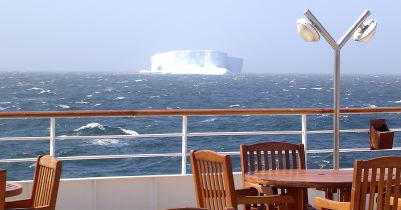

Dear All,
We had to set our watches forward an hour last night before going to bed, as South Georgia is significantly further east than the Falklands, as well as further south--so we slept "later" than usual and were surprised to hear the announcement at 8:30 this morning that the "Spot the first iceberg" competition had ended an hour earlier and that an eagle-eyed passenger had won the promised bottle of champagne.
The competition was announced in yesterday's daily bulletin which appears on our beds when they are turned down while we're at dinner, so we know what will be happening during the following day (and first thing in the morning, a four-page "newspaper" containing the biggest worldwide news items as well as sports information and occasionally some financial updates is slid under our door&emdash;different versions for different nationalities). To win the champagne, it had to be a true iceberg--at least as big as this boat--not one of the bergy-bits (house sized?) or a "growler", about the size of a VW bug.
We missed that one, but have seen several since and since lunch they are coming one after another--most of them "tabular".
These are ones that have broken off one of the Antarctic ice shelves, which is why they are flat on top. The pointed ones are apparently bits of icebergs that have broken up, and growlers are very small, with very little showing above the water. They're the ones you want to have good eyes looking for, as they can be very much bigger&emdash;and sticking out dangerously&emdash;under the surface.
(An aside: it was in 2002 that an enormous portion of the Larsen Ice shelf (which projected out onto the sea on the east side of the Antarctic Peninsula&emdash;we will be making our stops on the west side) collapsed, breaking off from the ice covering the continent&emdash;3250 square kilometres, in fact. This then shattered into thousands of icebergs that were then adrift in the Weddell Sea.)
Although I felt I had a lot left to say about the Falklands, there is a crowd of people talking at the bulletin board which is right in front of the e-mail desk at the entrance to the library and I am having trouble thinking (which may be a relief for you readers!). Basically, to wrap up the Falklands, I'd say that the bright colors of the buildings (mainly the roofs, except in the photo below) and the stalwart attitude of the inhabitants were striking.
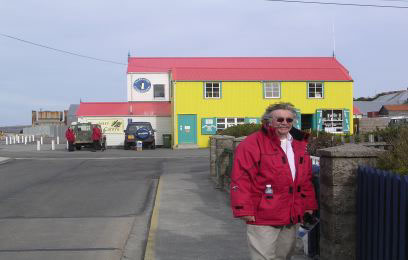
There seems to be a firm determination to remain British, although I've heard there are a few murmurs about independence, now that the island is becoming financially self-sufficient. We had an interesting chat with the woman managing a small hotel we passed on our way back from our "audio walk"&emdash;needing a pit stop, we were relieved to see a sign saying that the Malvina Hotel (interesting name, given the war 25 years ago) was open to non-residents.
We ended up having a cup of tea and were amazed that behind the slightly flaking white facade with green trim lay a sleekly sophisticated restaurant and bar of polished steel and dark grey upholstered suede that would have been at home in any large city. We were intrigued to find that the woman in charge is originally from St. Helena, the volcanic island in the South Atlantic that was Napoleon's home for his last years. She had only arrived in July (winter in the southern hemisphere) and said the winter had been okay but the summer had been so bad, with snow last week, that she was thinking she might not stay. The snow must have been very short-lived, as there were small displays of flowers in a lot of the front gardens along the main street, and gorse or broom was in full golden bloom all around the town in tight banks of yellow.
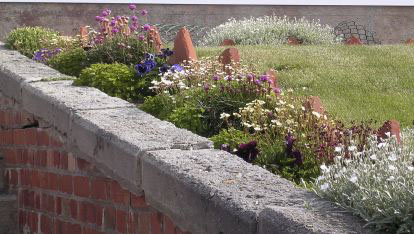
We unfortunately missed the museum, which has a small cottage that is set up as it would have been when lived in by early settlers, which I'd have loved to see, but by the time we were a few blocks away, it was 2 minutes to closing, so we headed back into town.
As we were taking one of the shuttle buses back to the dock, we saw one of the Filipino waitstaff pedalling away to get back to the ship. These fellows (and ladies&emdash;there are a few, although the cabin stewards seem to be all men, as are the waiters&emdash;the women seem to be the drink dispensers) are often on the ship for 6 months at a time, or even a year&emdash;without taking any time off&emdash;banking their pay to go home to visit their families. It must be worthwhile, as the waiters, who all introduce themselves and get to know the passengers' names incredibly quickly, and are quite happy to talk if it's not too busy&emdash;seem to make lifetime careers of this. In fact, the ones we have spoken to most have been working on cruise ships together for 15 years. A nice compromise in terms of informality prevails on board: when we sit down at our table, we are greeted with "Hello, madam Kate," and "How are you, sir, Roger?" (purposeful second comma). I am almost getting used to having a napkin shaken out for me and put on my lap... and the food continues to be delicious, from the hot and sour shrimp soup we had as part of today's Asiatic lunch to the old-fashioned rice pudding for dessert. No tea today--there has to be some limit!
This morning we had 2 interesting lectures, and I've got time to write before we must all get our wellies and bring them up to the pool deck to have them checked and cleaned. This is the first year that South Georgia has instigated serious "bio-security" procedures, in part because there have been various things (including rats!) brought in from passing ships that have caused a real problem for the local varieties of plants and "animals", as our experts call all groups of birds, animals, and even, I think, fish.
Because of these restrictions (at a group meeting we all had to sign a multi-point oath that we had followed very carefully the required cleaning/scrubbing/vacuuming procedures before we were "allowed" to leave the lounge, even though we had not actually accomplished any of the requisite tasks&emdash;yet!), the backpacks we were promised were only handed out last night, so we couldn't use them on the Falklands. Had we done so, they would then have had to be vacuumed inside and out, especially along the seams in case any seeds had caught there, before being allowed to land on South Georgia. This way, we don't have to worry about them.
We have also had a very detailed lesson about getting into, staying seated in, and getting out of the Zodiacs, and have also been shown pictures of what it can be like if it gets a bit "bouncy", in terms of the sea, so we will not be too surprised if we have to skip some of our hoped for landings, because of rougher seas. No one who did not attend the lecture and hand in the form about boot cleanliness will be allowed ashore from now on, so everyone had to be physically present to be checked off lists several times. For once, no one could remain in their cabin watching the meeting on the in-boat channel, as one can do for the other lectures.
Tomorrow morning should be our first landing on South Georgia, and yesterday afternoon and this morning we had fascinating lectures by Bob Burton, the historian with whom we had lunch recently. The first was on Shackleton and his expeditions/challenges and ultimate resting place on South Georgia (after his unhappy wife in England &emdash;said Bob B&emdash;replied when asked about having his body returned to her that she didn't want him in England as he had clearly preferred South Georgia to her company). The second introduced us to the history of South Georgia. It's amazing how completely ignorant I was (slightly less so now)&emdash;he was delightfully informative. We have a booklet written by Bob that was included in the packets for each passenger from the Governor of South Georgia (to make one feel better, I suppose, about the £50 per person landing charge&emdash;already included in our overall fees&emdash;which will be paid by the ship's master tomorrow before we disembark); we plan to keep whatever we can in terms of written info from the voyage both so we can help ourselves remember the trip later and also so anyone who wants to see more details can do so.
We also had another lecture by the wonderful Uruguayan "bird lady", Patricia, who today was talking about penguins. We didn't go on the trip to a cove full of penguins in the Falklands, as we knew we'd see lots of them in South Georgia and Antarctica, and viewing the PowerPoint slides this morning of the various varieties we can expect to see was amazing. She has a great way of imitating the different walks of the different species and sizes that really keeps one awake! Some of the penguins are quite petite and weigh in at about 8-9 pounds. And others (which stunned me) can be nearly 4 feet tall and weigh about 80 pounds. Yikes!
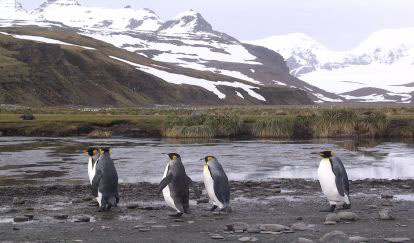
King penguins, identifiable by the orange markings on their heads and the yellow/orange coloring around the throat.
We've been given very clear directives about how to behave around "the animals", primarily so we don't disturb them, but also to keep ourselves secure. The penguins generally are curious, not aggressive, and although we are not allowed to touch them&emdash;in fact must not approach closer than 15 feet&emdash;they can, and apparently will, approach us. We've been advised to get down on our knees to photograph them, so as to get a better perspective, but no mention was made about how some of us (perhaps many of us, given the average age) are going to be able to get back up again!
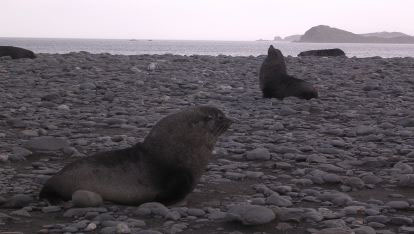
One animal I plan to give a wide berth to is the fur seal.
Charley Wheatley, an American professor of oceanography who also lives in San Diego and who is a friend of Pat Abbott, the geologist, gave us a fascinating and cautionary talk about the different types of seals we'd be seeing--from elephant seals with enormous schnozzes as well as huge, blubbery bodies (I think up to 5 tons in the dominant males!), which may be mistaken on the beaches for big boulders, so we ought to look twice before sitting anywhere, to fur seals, which are vastly smaller ("only" 500 pounds for the males) but quite nasty, especially the males which stake out their territory when on land for breeding and will charge and bite anyone/thing that trespasses upon it. One explanation I heard afterwards for this very aggressive behavior was that the males are nearly blind, so when they see something invading their territory, whether human or another seal, their weak eyes perceive it as a shape that is rearing up (as in a male seal interloper/competitor) even if it's a human who is standing up. I had wondered whether "fight rather than flight" after the decades of sealing which destroyed much of the seal population might have become an inbred response, but apparently it's down to bad vision.
This morning, with Patricia, we learned about not only the different varieties of penguins (some of which have millions of them all through the South Ocean, including all the way up to an island almost on the equator, off the west coast of South America, so they do not need a cold climate), but the different behaviors they have, from mating to taking care of their chicks. One group (afraid I forget which) has an interesting schedule: the breeding males come onto land first (always returning to the place where they were born), followed two days later by the younger males which may have to do a lot of standing around, watching (and presumably learning?), and after a week, the females arrive, and look around to see what sorts of nests the first groups of males have prepared for them. With another species, the males can be seen carrying around stones in their beaks all through the mating period, as if to say to potential mates that they will always be ready to repair and improve the nest, so would be a good choice. It's wonderful to have these insights presented to us without having to go through long, cold months in a scientific "hide" collecting information!
Although the Enrichment Lectures are universally wonderful, sometimes there are extremely interesting tidbits (I just can't use the British form, "titbits"!) that come up in informal chats later. One gem, related to one of Bob's lectures, was the auctioning of the last remaining "sea biscuit" from Shackleton's tent on one of his last expeditions; this chunk of celebrity hardtack went for 3000 dollars! As Bob the historian said, anyone who thought that Shackleton, who was starving at the time, would have left uneaten that last biscuit almost deserved to be rooked.
We were enjoying Bob's story about the challenges of "ringing" the legs of albatrosses when he was on Bird Island back in the 60's--these are huge birds and have long bills with a big hook at the end; adept as he got, he still has scars on his hands from the ones that nearly got away, 40 years ago--while eating a super lunch, when another iceberg hove into sight, and we felt that things just couldn't get much better.
Now, time to get my boots out to the scrub area (we'll walk through strong disinfectant both coming and going from the ship for each landing, too), then maybe, for the first time since we got on board, I'll actually have a little time to read before this afternoon's "enrichment"!
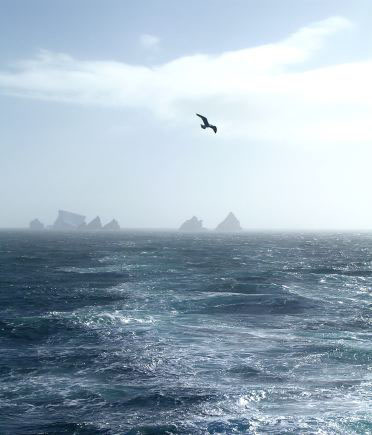
About 150 miles west of South Georgia: a giant petrel or albatross glides, and in the background, pointed Shag Rocks and a slightly tilted tabular iceberg.
Hugs to you all--and from Roger, too, who has had 3 new people meet him about bridge after a notice was inserted into today's bulletin (by some helpful staff person--he didn't ask for this, and almost missed it, as he hadn't read every single word carefully&emdash;the staff here are very quick to smooth the way for us in any possible way).
Kate
From Buenos Aires to Tierra del Fuego (Part 1)
© 2008 Kate Woodward
PROMETHEUS, Internet Bulletin - News, Politics, Art and Science. Nr. 131, May 2008